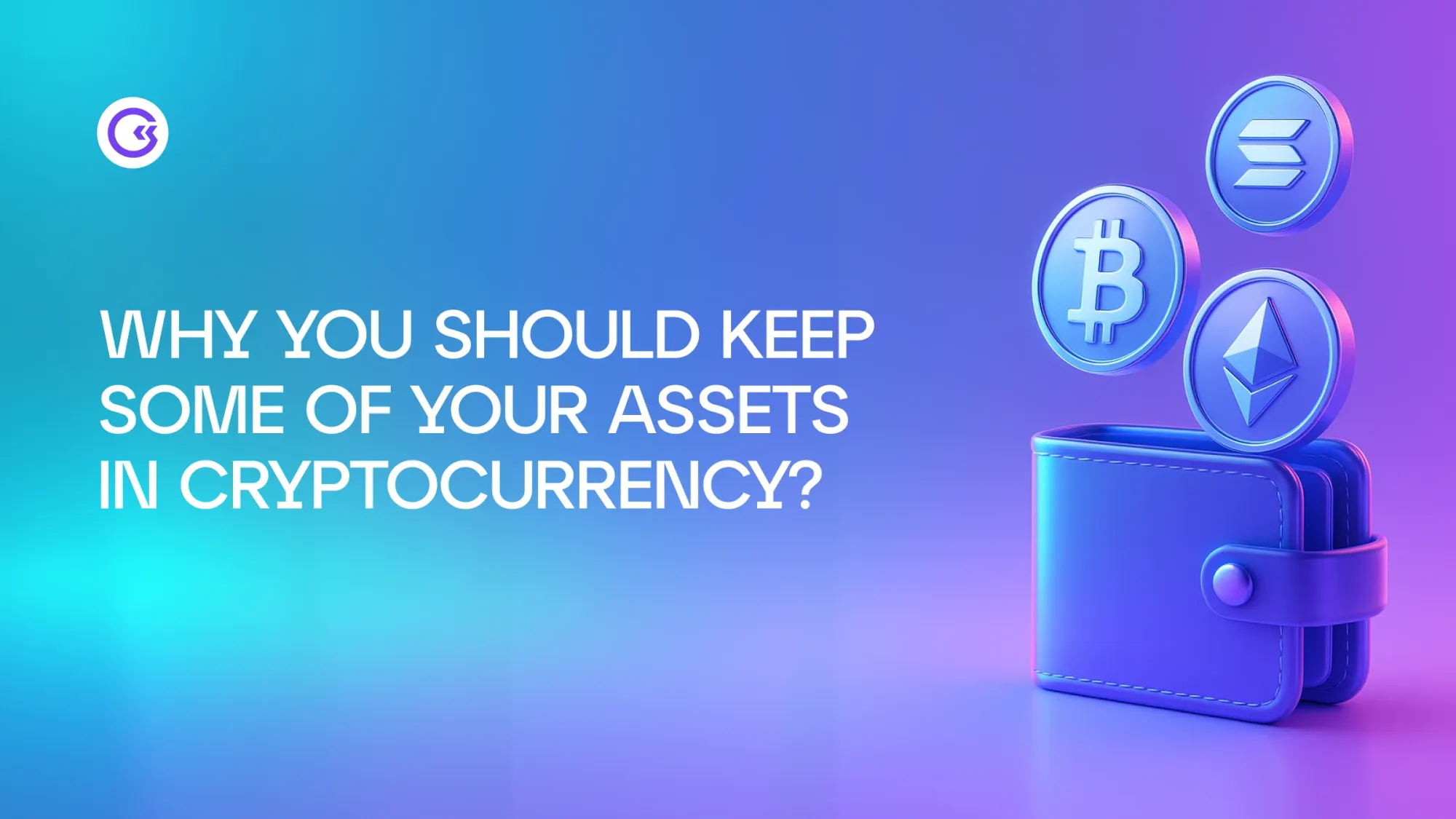Introduction
Holding cryptocurrency is no longer just a niche experiment. It is becoming part of how people structure modern portfolios around the world. The point is not to place everything in digital assets but to set aside a portion that balances innovation with risk. Going all-in can magnify volatility, while ignoring crypto means missing exposure to one of today’s most dynamic financial systems. A careful allocation allows you to capture upside potential while keeping your foundation in familiar assets such as stocks and bonds.
The Case for Cryptocurrency as an Asset Class
Why is cryptocurrency important in today’s financial landscape? It introduces a form of value that is not bound to a central bank, yet can be exchanged across borders with ease. Unlike stocks or bonds, which are tied to corporate performance or government debt, digital assets exist on decentralized networks powered by blockchain. This independence is what makes them stand apart from traditional securities.
Large institutions have started to notice. Pension funds, insurance groups, and family offices are exploring crypto as a hedge against systemic risks and as a source of non-correlated returns. The growth of exchange-traded products, licensed custodians (professional storage of digital assets), and clearer regulations shows that crypto is no longer an outsider.
Spot Bitcoin ETFs in the United States and other jurisdictions, custodial services offered by established banks, and new guidance from financial authorities all point to mainstream acceptance. Together, these developments lift cryptocurrency from a speculative bet to a recognized component of diversified portfolios.
Benefits of Keeping Some Assets in Cryptocurrency
The benefits of crypto trading and holding go well beyond short-term price moves. Allocating a portion of your portfolio to digital assets can build resilience and open doors to innovation.
Diversification
Crypto often moves independently from stocks and bonds. By blending digital assets with traditional holdings, you reduce the risk of being fully exposed to one market cycle. This non-correlation provides balance when conventional markets dip, helping smooth portfolio performance.
Hedge Against Inflation and Currency Devaluation
Bitcoin is often described as “digital gold” because its fixed supply is designed to make it resistant to inflation. In regions with fragile economies, well-collateralized stablecoins pegged to the dollar have also become important substitutes for local money, giving people a way to protect spending power when national currencies falter.
High Growth Potential
Early-stage technologies such as decentralized finance (DeFi), NFTs, and the metaverse represent more than trends. They are experiments in how value, art, and commerce can evolve. Holding crypto provides exposure to these frontiers and gives you a chance to participate in areas that may reshape industries over the next decade.
Global Accessibility and Liquidity
Unlike traditional markets that close on weekends or depend on banking hours, crypto operates around the clock. Transfers move across borders in minutes, bypassing delays and costly intermediaries. This accessibility and constant liquidity make digital assets unusually flexible in a global economy.
Another layer of accessibility lies in remittances. Migrant workers sending money home often face high fees. In many cases, stablecoins and Bitcoin provide a cheaper, faster option. In countries such as the Philippines and Mexico, families now use crypto-based remittance channels to receive funds quickly.
The same channels have supported humanitarian aid in crisis zones where banks cannot operate. For businesses, crypto payments expand customer reach without requiring multiple bank accounts or currency conversions. These examples show that accessibility is not only about trading 24/7 but about financial inclusion for people and companies once locked out of the system.
Risks of Allocating to Cryptocurrency
Understanding why to buy cryptocurrency also means understanding the risks. Volatility is the most visible. Prices can rise or fall by double digits in a single day, creating both opportunity and stress. These swings reflect the speculative cycles that still dominate digital markets.
Security is another concern. Digital wallets require private keys, and losing them means losing access to funds permanently. Hacks and phishing scams remain a threat, especially on poorly secured platforms. Choosing where and how to hold crypto is as important as deciding how much to allocate.
Regulation adds uncertainty. Countries treat crypto differently, ranging from supportive frameworks to outright bans. This patchwork complicates everything from tax reporting to cross-border transfers.
The market has also seen bubbles fueled by hype-driven projects. When attention pours into a token or trend without solid foundations, collapse can be swift. For newcomers, learning to tell the difference between genuine innovation and empty promises is essential to avoid costly mistakes.
How Much of a Portfolio Should Be in Crypto?
How much of portfolio should be crypto is a question without a single right answer. What matters most is aligning allocation with your tolerance for risk. For cautious savers, a conservative slice of 1 to 3 percent provides exposure without putting core capital at risk. Those more comfortable with uncertainty may go higher, sometimes 5 to 10 percent, but the goal is balance rather than chasing maximum returns.
Professional advisers generally warn against extremes. Putting all of your wealth into digital assets is dangerous because volatility can wipe out large sums quickly. Excluding crypto altogether, however, means missing one of the most innovative areas of modern finance. A balanced approach lets you capture the upside while protecting long-term stability. Crypto should not replace stocks or bonds but complement them in a diversified strategy.
Tools for Safe Allocation
When to buy cryptocurrency is only part of the decision. The bigger challenge is how to hold it safely. One layer of protection is a hardware wallet, a device that keeps private keys offline and out of reach of hackers.
For those who prefer the convenience of exchanges, it is essential to choose platforms that are regulated and transparent about custody practices. These services add security but should still be paired with personal caution such as two-factor authentication.
For broader exposure without direct custody, crypto exchange-traded funds (ETFs) and index products (bundled funds that track a group of assets) offer a structured entry point. They track underlying assets while simplifying compliance and reporting.
Finally, allocation is not a one-time act. Portfolios change over time, and rebalancing helps maintain the proportion of crypto exposure you intended at the start. Adjusting the slice regularly keeps your strategy aligned with long-term goals.
Case Studies: Crypto Allocation in Practice
Why buy crypto is easier to understand when you look at how others are doing it. At the institutional level, big names have added Bitcoin to their reserves. Companies like Tesla and MicroStrategy did not make symbolic purchases. They reframed crypto as part of their treasury strategy. Pension funds and hedge funds have also tested the waters, experimenting with controlled slices that give them exposure without compromising core positions.
On the hedge fund side, managers are trying diverse approaches that range from direct coin holdings to using derivatives (contracts tied to future prices) for risk management. For them, crypto is another arrow in the quiver, sitting alongside equities, bonds, and commodities.
Individual stories show the same trend. In inflation-hit countries like Venezuela, Turkey, and Argentina, people use stablecoins and Bitcoin to preserve everyday value when their national currencies lose credibility. These are not speculative bets but lifelines that protect household savings and enable cross-border payments.
Balanced portfolios that mix stocks, bonds, and a measured slice of digital assets also offer a model. The crypto portion may be small, but it provides diversification, a link to innovation, and peace of mind that wealth is not tied to a single system.
Institutional momentum has grown further with the launch of spot Bitcoin ETFs in the United States. Within weeks of approval, BlackRock’s iShares Bitcoin Trust attracted billions in inflows, showing that digital assets are being treated like mainstream securities. Endowments from universities such as Harvard and Yale have disclosed small allocations, seeing crypto as both a hedge and a source of long-term growth.
On the hedge fund side, strategies now include arbitrage between exchanges, structured products that limit downside, and derivatives designed to capture volatility without holding coins directly. For individuals in emerging economies, the case is even more urgent. Remittances sent home through stablecoins reduce costs and bypass unreliable banks. Together, these stories show that crypto allocation is not just theory but practice across institutions, funds, and households.
The Future of Crypto in Portfolios
Looking ahead, crypto is likely to move from an alternative experiment to a permanent feature of wealth management. Traditional banks and asset managers are already building services that integrate digital assets with stocks and bonds, letting clients view all holdings in one place.
Tokenization of real-world assets, from real estate to art, is opening the door for fractional ownership that was once impossible, giving more people access to markets that used to be reserved for the wealthy.
Technology is also making allocation more precise. AI-driven portfolio strategies can analyze patterns across traditional and digital markets, adjusting exposure to balance risk and opportunity. The long-term outlook points toward crypto becoming a standard allocation of 5 to 10 percent in diversified portfolios. This would mark a move from hype to normalization, where digital assets quietly work beside traditional ones to protect and grow wealth.
Tokenization is already moving from concept to practice. Governments have issued pilot bonds on blockchain networks, allowing instant settlement and transparent debt tracking. Real estate firms are testing tokenized property shares, letting investors own fractions of buildings that once required millions.
Luxury brands are using tokens to certify authenticity, blending physical and digital value. At the same time, regulators are drafting clearer rules for tokenized assets. Combined with AI-driven allocation tools, these trends suggest a future where traditional and digital assets form a single portfolio view. In that system, crypto is not hype but an early piece of a broader financial infrastructure.
Conclusion
Cryptocurrencies are best seen as a complement, not a replacement, for traditional assets. They bring unique advantages like diversification, inflation protection, and access to global innovation, but they also carry risks that require discipline and careful planning. A small, well-considered allocation may deliver meaningful benefits without putting overall stability at risk.
Even a modest share of digital assets provides exposure to a rapidly evolving financial system while keeping the core of wealth in familiar territory. The future of portfolios is not about choosing one side over the other but about blending old and new to strengthen resilience and open new opportunities.
Further Reading
Want to go deeper? Here are some guides and resources that expand on the ideas in this article.
- Corporates using crypto (Deloitte)
- Does crypto deserve a place in portfolios? (J.P. Morgan)
- 10 reasons to buy cryptocurrency (CoinLedger)
- Risks and benefits of crypto (Fidelity)
- Diversification benefits (Investopedia)
- Crypto basics (Coinbase)
- Cryptocurrency explained (NerdWallet)
- Cryptocurrency stocks (Motley Fool)
- What is diversification? (Kraken)
- Learn crypto (CoinDesk)
FAQ
Why should I keep some assets in cryptocurrency?
Because crypto behaves differently from traditional markets. It adds diversification, offers potential protection against inflation, and connects you to innovations like DeFi and global payment rails. A small allocation helps balance risk and opportunity.
How much of my savings should go into crypto?
There is no universal number. Many advisers suggest between 1–10%, depending on your comfort with risk. The key is choosing a level that will not jeopardize your financial stability if prices swing sharply.
Is Bitcoin safer than altcoins for long-term holding?
Bitcoin has the longest track record, strongest network security, and widest recognition. That makes it less risky than many smaller tokens. Altcoins can bring growth opportunities, but they also carry higher volatility and greater failure rates.
What are the risks of putting money into cryptocurrency?
Digital assets can be highly volatile, regulations differ across countries, and scams or hacks are real threats. Using secure storage, sticking to reputable platforms, and keeping allocations modest helps manage these risks.
Can crypto protect my portfolio from inflation?
Bitcoin is often described as “digital gold” because of its fixed supply, making it appealing in inflationary times. Stablecoins pegged to strong currencies can also provide some level of protection in places with weak local money. Neither is foolproof, but both can add resilience.
Are stablecoins a safe way to keep assets in crypto?
Stablecoins are designed to track the value of a fiat currency, usually the dollar. They are useful for everyday transactions and shielding against local currency drops. Still, they depend on the issuer’s reserves and oversight, so choosing regulated, transparent projects is essential.
October 13, 2025











